The processes of recording, editing, and mixing audio have never been as much in the hands of artists as they are now. Today, you don't have to go to a professional studio to record audio for podcasts, broadcasts, or music production! You can still do it, but it’s not necessary.
You don’t even need expensive audio equipment for your home studio, either. If you're just starting out, all you need is a computer, audio editing software, and a microphone.
In today's article, you'll find the best audio editing software for Windows. From free software to paid licenses and subscriptions, you’ll have different choices to produce podcasts or music with high-quality audio for your demanding audience.
Let’s dive in!
Best Audio Editing Software for Windows Comparison Table
Here's a glance at the best audio editing software for Windows before diving into each one. In the following chart, you can compare our best picks for audio editing software by key features, price, what's best for you, and difficulty level.
| Key Features | Best for | Skill-level | Price | |
| Adobe Audition | Multi-track editing Audio restoration | Audio restoration, advanced audio editing, and sound design | All levels | Single subscription $22.99 Creative Cloud All Apps $59.99 |
| Audacity | Audio recording Multi-track editing Audio effects Noise reduction tools | Audio editing and audio restoration | Beginners, intermediate | Free |
| Ableton Live | Full-featured DAW Live-oriented workflow Plenty of effects and instruments | Music producers and live performers | All levels | Live Intro $99 Live Standard $439 Live Suite $749 |
| Fl Studio | Pattern-Based Workflow Step sequencer Plenty of effects and instruments | Beat Making and music production | All levels | Fruity Edition $99 Producer Edition $199 Signature Bundle $299 All Plugins Edition $499 |
| Pro Tools | High-quality audio recording Multi-track editing Powerful and professional editing tools | Professional music producers, scoring, and sound designers | Advanced | Pro Tools Intro FREE Pro Tools Artists $9.99 Pro Tools Studio $34.99 Pro Tools Ultimate $99 |
| PreSonus Studio One | Intuitive Drag-and-Drop Workflow Chord Track Harmonic Editing Scratch Pad | Music Production | Intermediate to Advanced | Studio One Pro license $399 Studio One+ $19.99 monthly Studio One+ Hybrid $179.99 yearly |
| REAPER | Fast and lightweight Multi-tracking Highly customizable | Sound designers, music production on a budget | All levels | $60 |
| Acoustica | Multi-track editing Audio restoration External plugins support ARA2 and Host Integration | Audio editing, restoration | Beginners | Standard Edition $59.90 Premium Edition $199.90 Post Production Suite $299.90 |
| Audio Mass | Online browser-based Audio effects Waveform and frequency visualization Dockable UI MP3 export | Basic audio editing Quick edits | Beginners | Free |
Here are our top 9 picks for the best audio editor for Windows users, in no particular order.
Adobe Audition - Best Overall
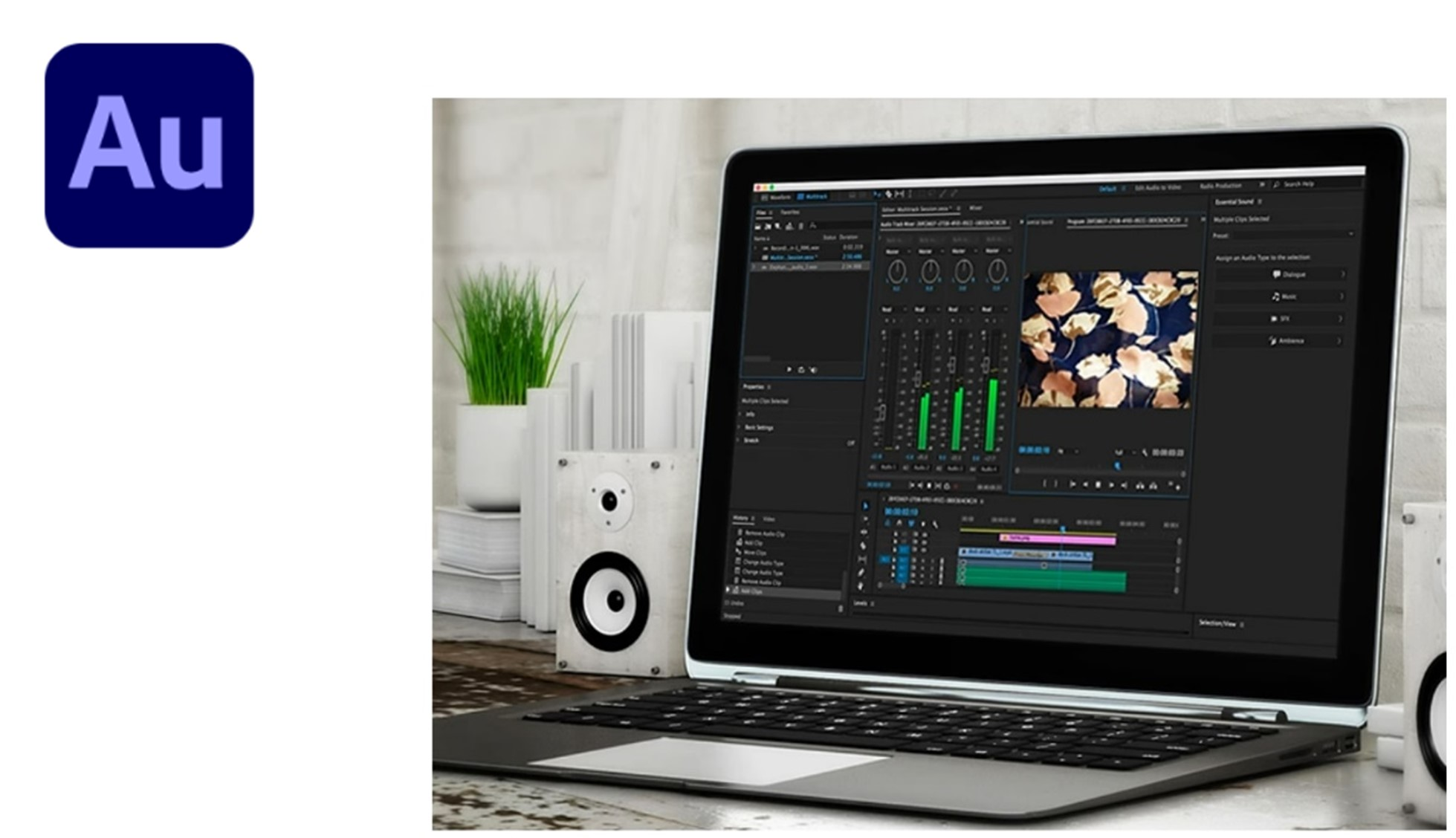
Adobe Audition is an audio editing software with comprehensive features and powerful audio restoration tools.
Adobe Audition is suitable for all skill levels. Its intuitive user interface and many tutorials help users overcome the learning curve. As a result, it has become a staple in the world of podcasting, vlogs, sound design, and professional audio editing.
With Adobe Audition, you can go from cutting and trimming to editing audio with advanced features such as audio restoration, applying effects, and integration with other Adobe products.
You may also like: Complete Guide: Record in Adobe AuditionKey Features:
Multi-track recording and editing.
Professional noise reduction and audio restoration tools.
Extensive built-in audio effects.
Waveform and Spectral Frequency editing.
Essential sound panel. A beginner-friendly tool to improve audio quality.
Third-party plug-ins support.
Audio mixing and mastering.
Seamlessly integration with other Adobe Creative Cloud Products such as Premiere Pro and After Effects.
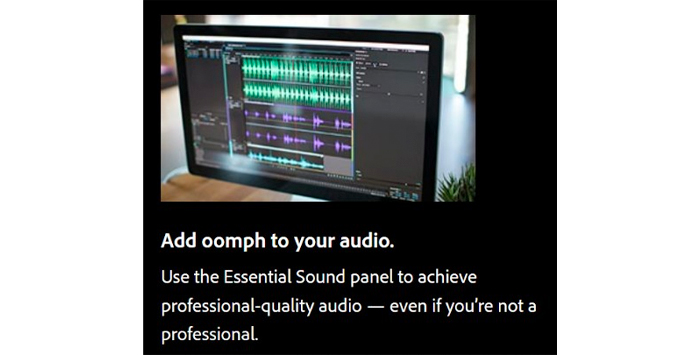
Adobe Audition is only available as a subscription plan. There are two options depending on your needs.
Audition subscription for $22.99 monthly.
Creative Cloud All Apps for $59.99 monthly.
7-day free trial.
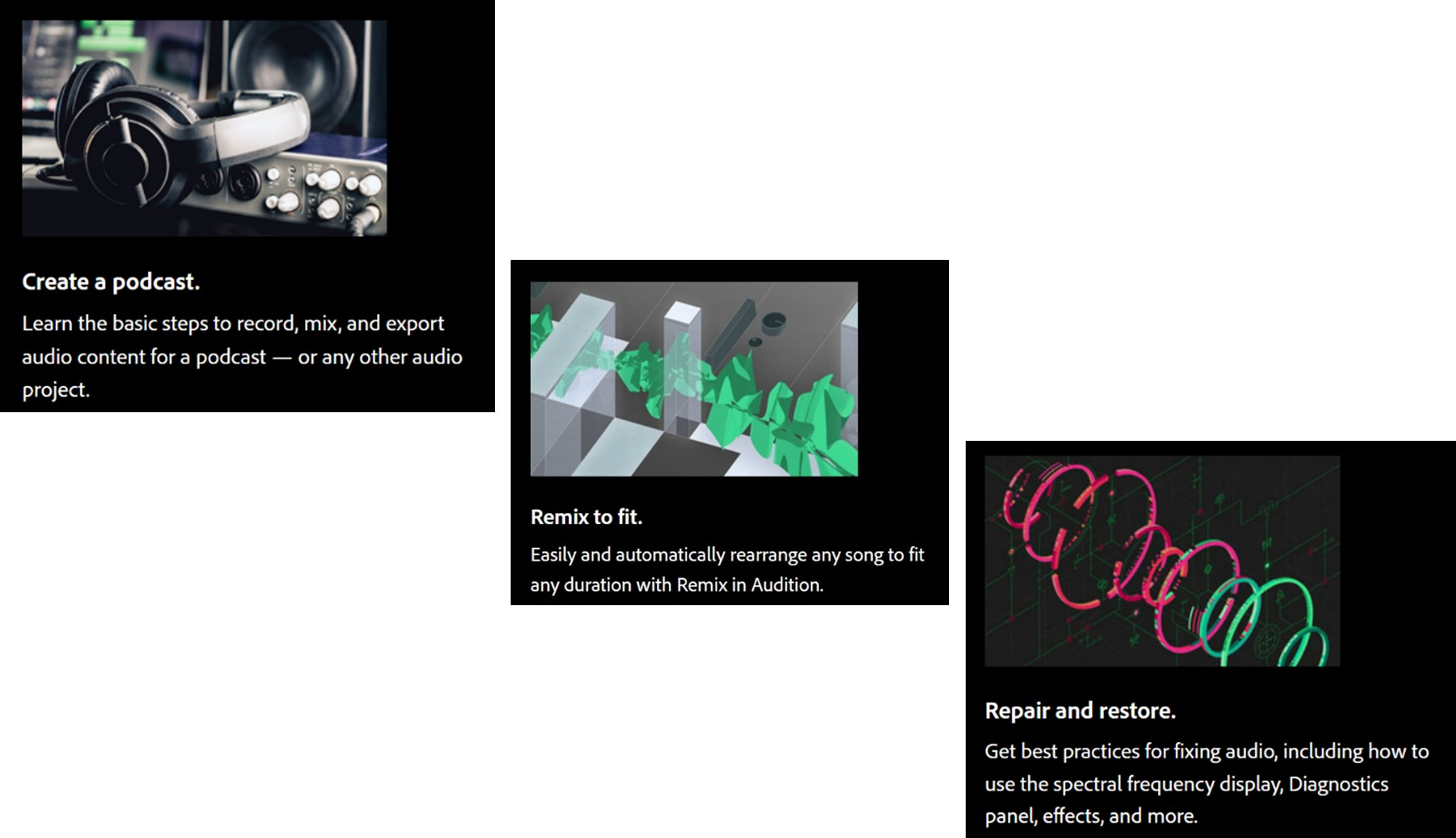
Pros:
Industry-standard restoration tools.
Easy to learn with a vast number of tutorials online.
Batch processing.
Supports multiple audio files formats.
Cons:
Subscription model only.
It does not support MIDI and virtual instruments.
Audacity - Best Free Audio Editor
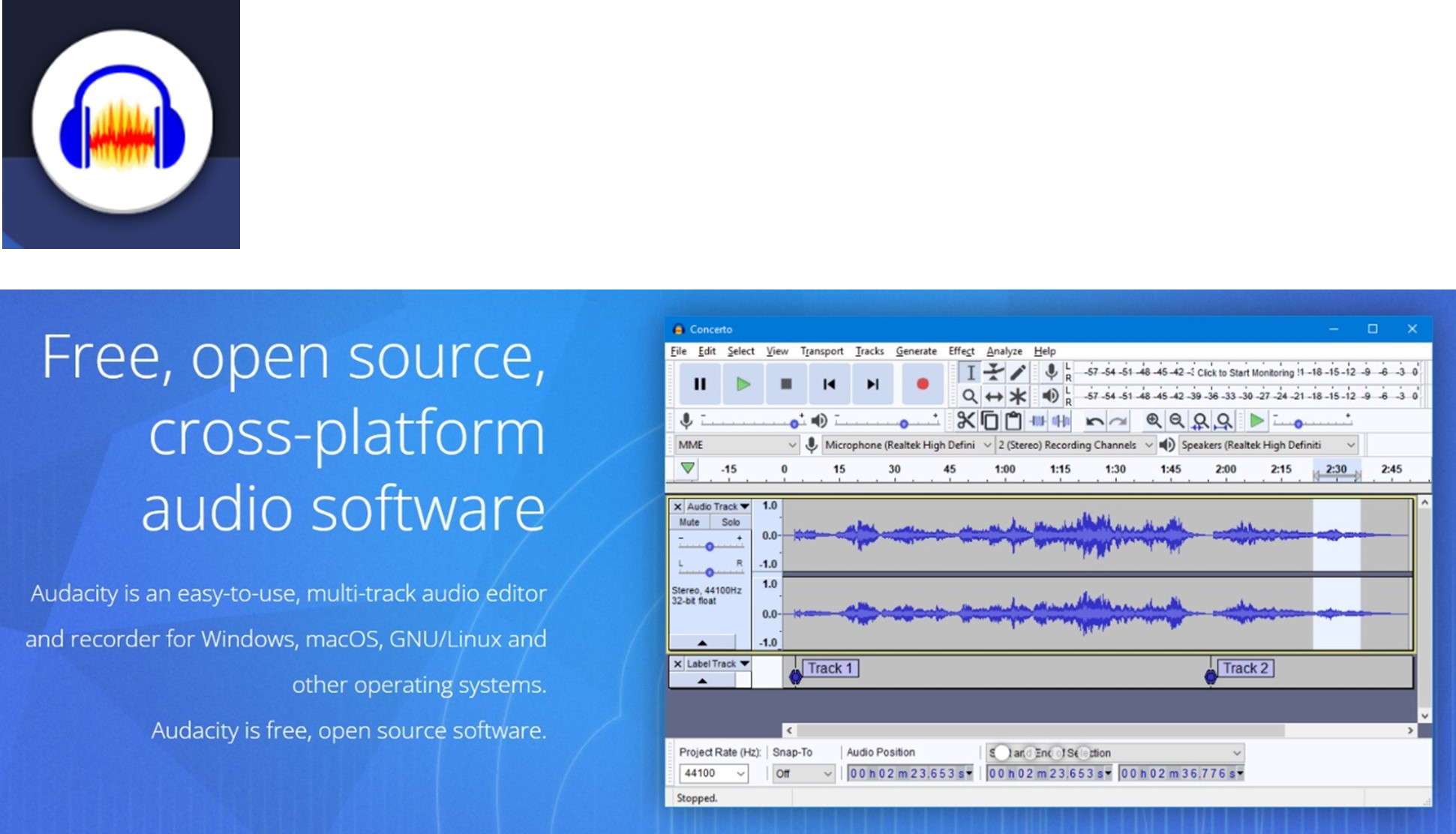
Audacity is an open-source, free audio editor for Windows users, starting with podcasting and audio editing.
It has a relatively friendly user interface that makes it great for beginners and intermediate users, with many tutorials online that teach you how to record, edit, and fix audio with Audacity.
It comes with a solid audio effects library, including noise reduction tools. Though its audio restoration tools are not as complete as Adobe Audition's, they can achieve professional sound for your podcasts once you learn all the ins and outs of Audacity and audio.
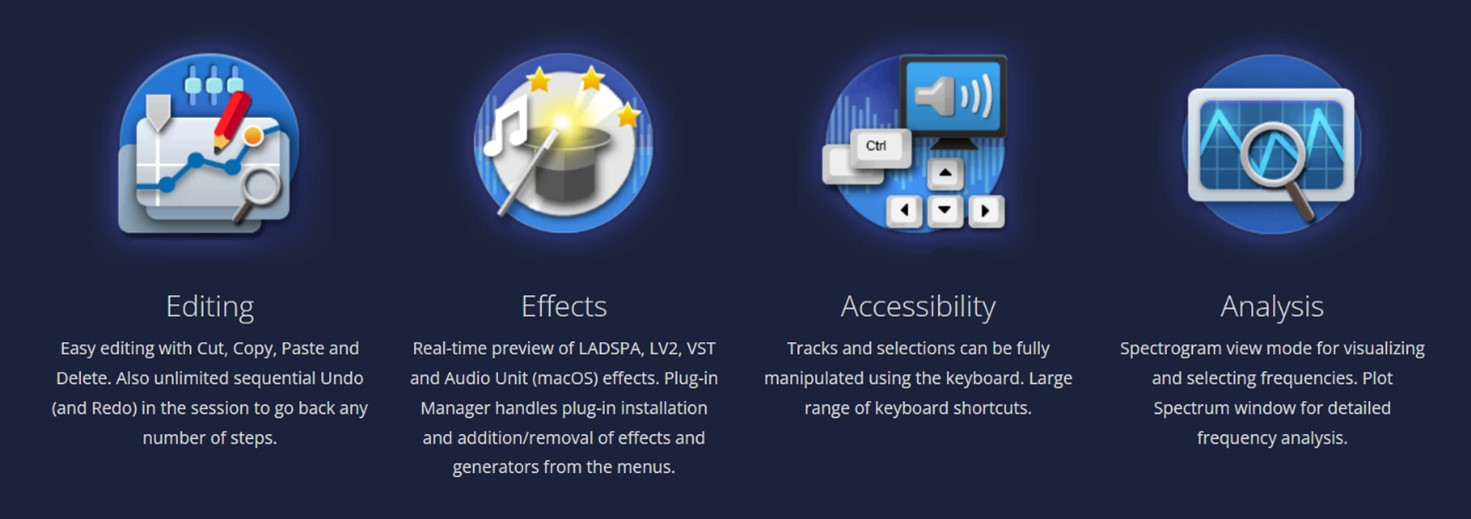
Key Features:
Audio recording.
Basic multi-track editing.
Solid audio effects library. Including EQs, high-pass and low-pass filters, noise reduction tools, reverb, and more.
VST audio effects plug-ins support.
Spectrogram view
Pitch Change tools
Wide range of audio files format support.

Pros:
It’s completely free and open source.
Import, export, and convert sound files in various formats, including WAV, AIFF, FLAC, MP2, MP3, and Ogg Vorbis.
Third-party audio effects plug-ins support.
Great online community support.
Cross-platform.
Cons:
Outdated interface.
Slow updates.
Limited advanced features for professional users.
Ableton Live: Best for Music Production and Live Performance
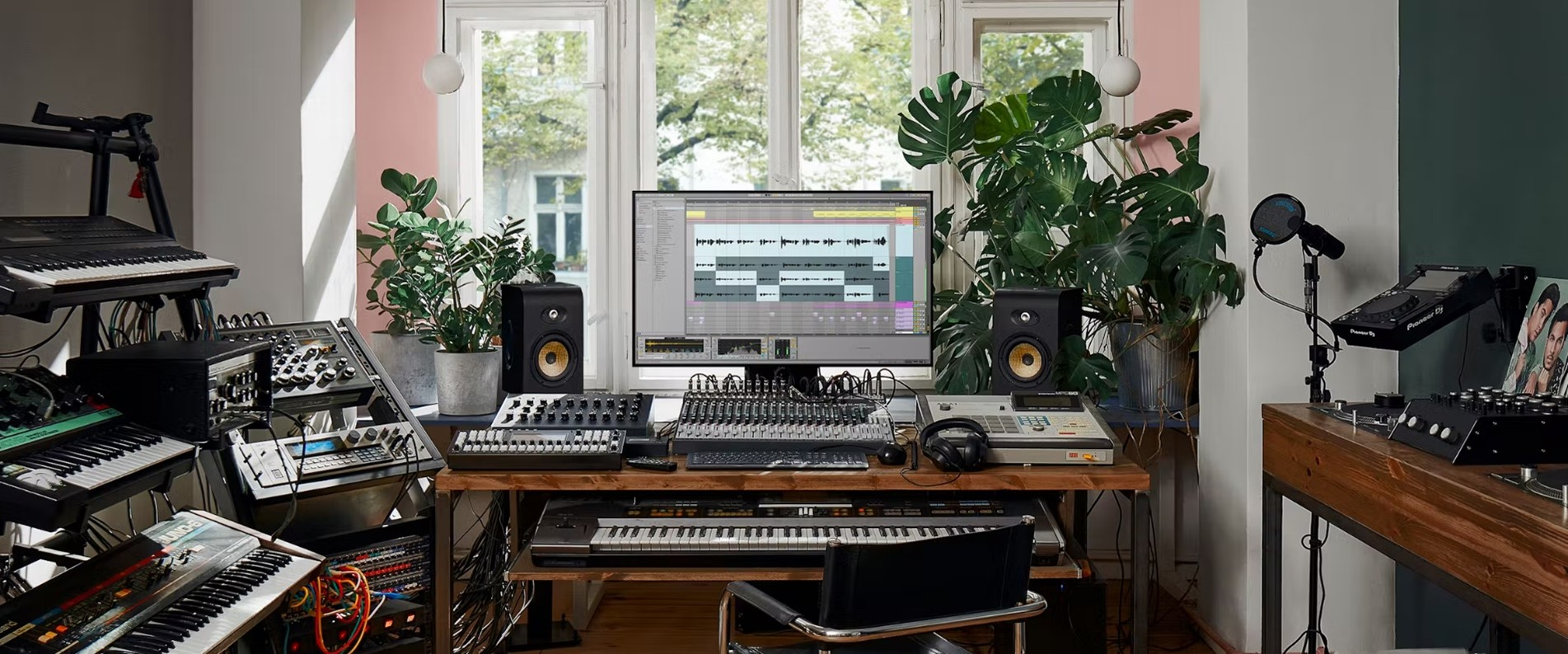
Ableton is one of the most popular digital audio workstations (DAWs) for music production, podcasting, and live performance. Its versatility makes it a perfect choice for those who prefer one tool for many purposes.
Ableton Live offers two workflow views. The arrangement view allows you to work with a traditional linear DAW interface and record and edit audio with the many built-in instruments and audio effects included.
Meanwhile, the session view gives you the tools for improvisation and flexibility for live recording or live performance.
Ableton might look intimidating for beginners, but it's so popular that there are recording tutorials for almost every question.
You may also like: Step by Step Guide: Record Audio in AbletonKey Features:
Jump between the Session and Arrangement views.
A big collection of audio effects, virtual instruments, and third-party plug-in support.
Max for Live allows you to customize and create instruments and effects in Ableton Live.
Push seamless integration.
Ableton Link.
Extensive MIDI and external hardware support.
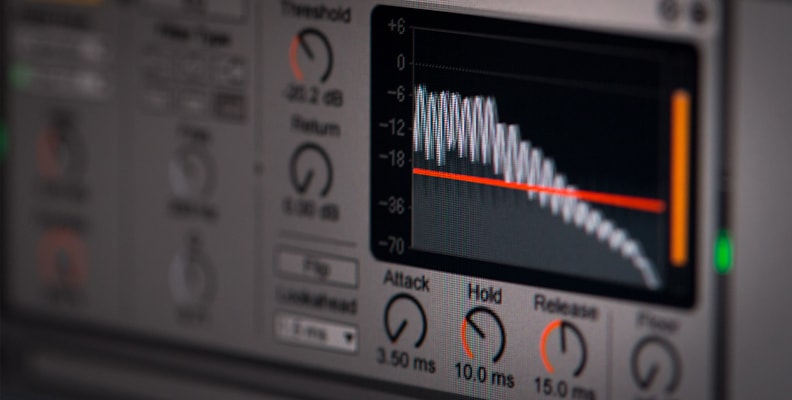
Ableton Live is available to purchase a perpetual license with a few options for different types of
The three Ableton Live licenses are:
Live Intro is $99. It comes with the essential tools for audio recording, editing, and mixing, 16 tracks, and over 5 GB of sounds to get you started.
Live Standard is $439 and includes full features, over 38 GB of sound, more virtual instruments, and audio effects.
Live Suite is $749. The complete studio version has over 71 GB of sounds, all instruments, and audio effects. It is the best package for music production.
You can try Ableton Live Suite for 30 days before purchasing it to determine whether it's the right audio editor for you.
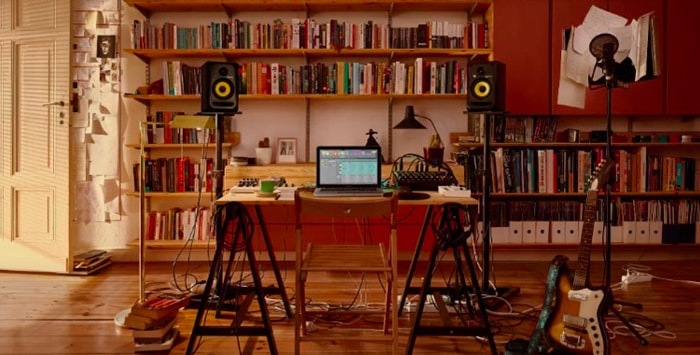
Pros:
Perpetual license.
Great user interface.
Versatile and flexible.
Vast amount of tutorials online.
Cons:
Steep learning curve.
Price.
FL Studio - Best for Beat Making

FL Studio is music production software that's been a staple for producing electronic music, Hip-Hop, and beats for a while. It’s best known for its unique pattern-based workflow and step sequencer for crafting drum loops and melodies.
It allows audio recording, multi-track mixing and sequencing, advanced MIDI support, and third-party VST plug-ins.
One of the highlights of FL Studio is that it offers free lifetime updates with your license, making the first investment worth it after several years. You will always have the latest version of FL Studio with your original purchase.
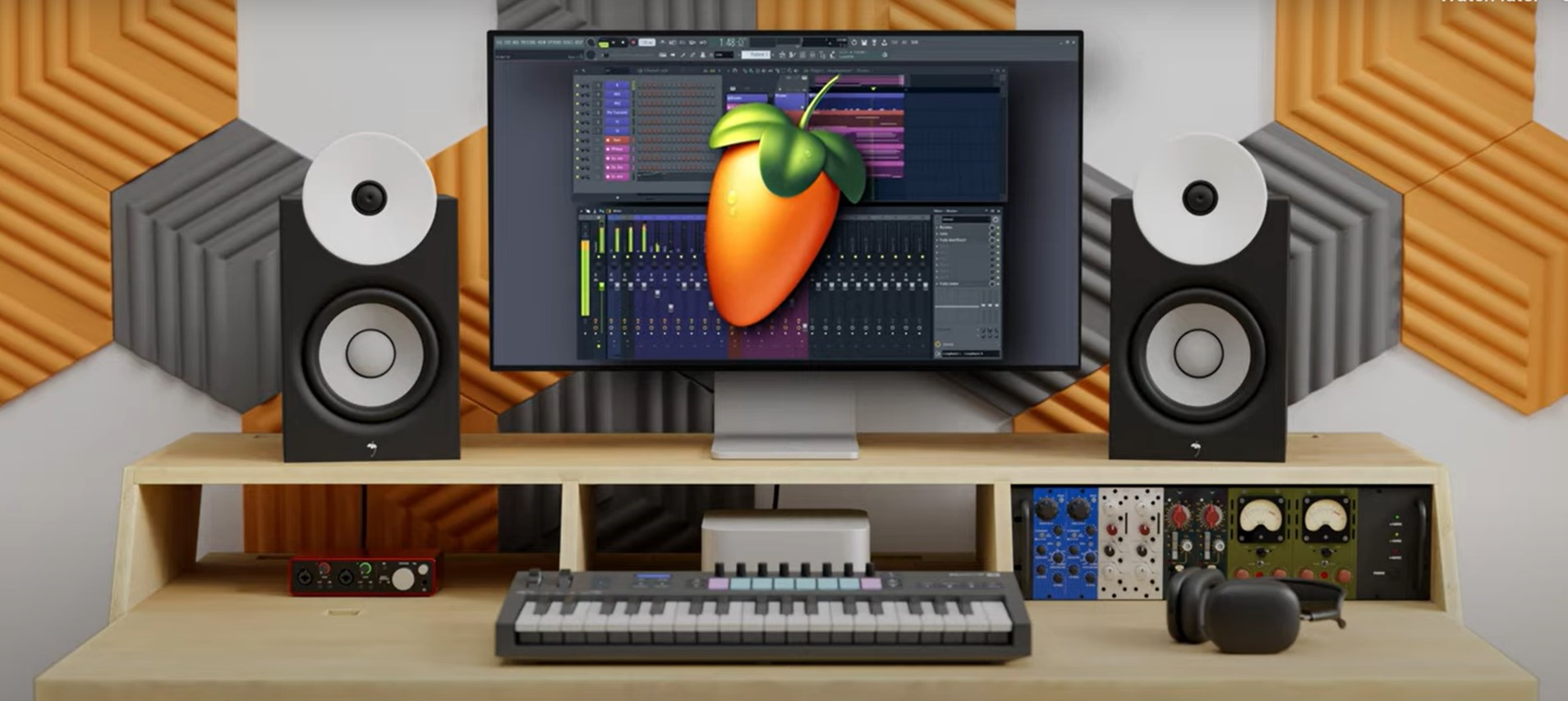
Key Features:
Pattern-Based workflow.
Step sequencer.
Playlist feature.
Multi-track mixing.
Piano roll.
Automation
Built-in virtual instruments and audio effects and third-party VST support.
MIDI support.
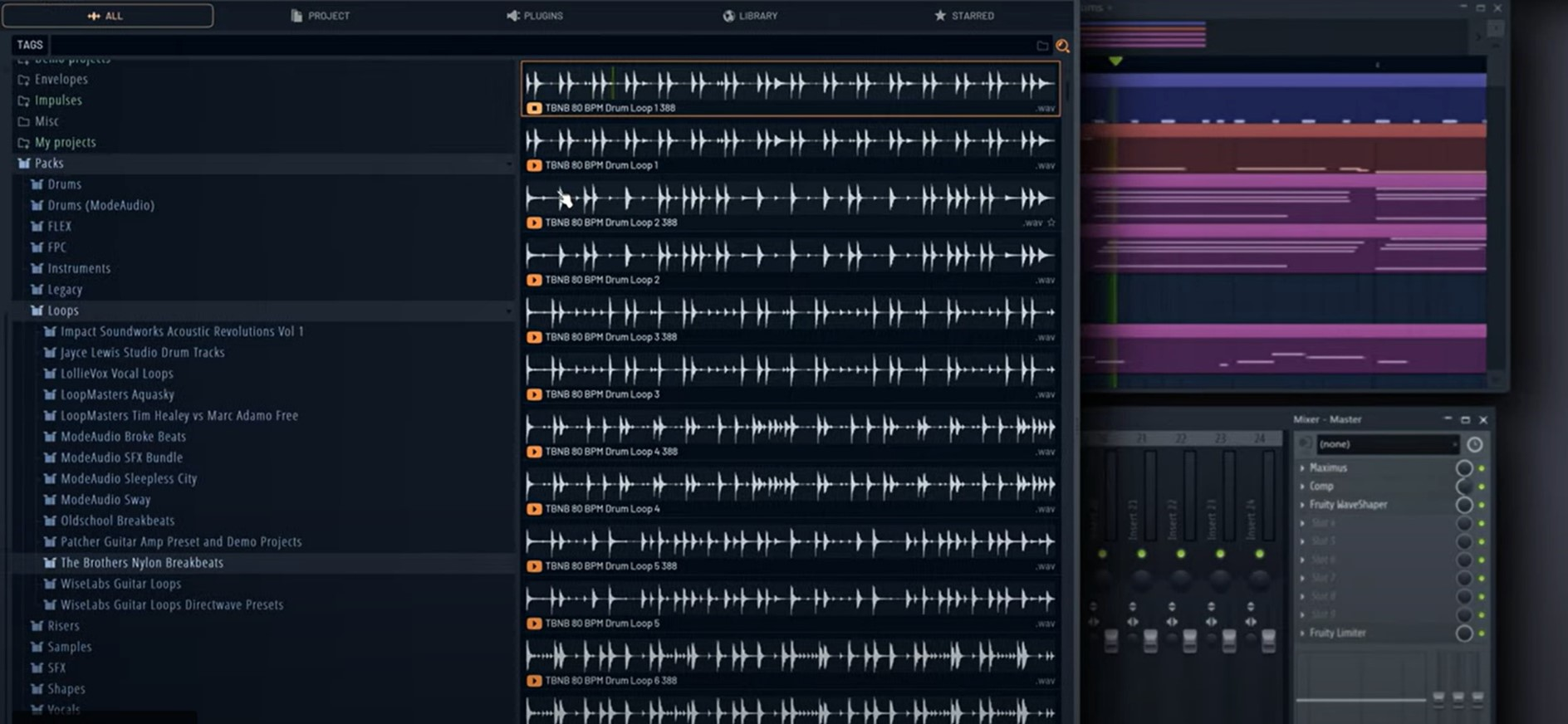
FL Studio is available in four editions with different inclusions and features.
Fruity Edition $99. It includes eight tracks and the essentials for audio manipulation but does not support audio recording.
Producer Edition $199. It features more instruments, audio effects, and audio recording. It’s the popular choice.
Signature Bundle $299. It includes more advanced plug-ins.
All Plugins Edition $499. The most fully featured version of FL Studio at a higher price.
There is a fully-featured trail version with unlimited time. However, you can only reopen the projects you save during the trial when you purchase a license.
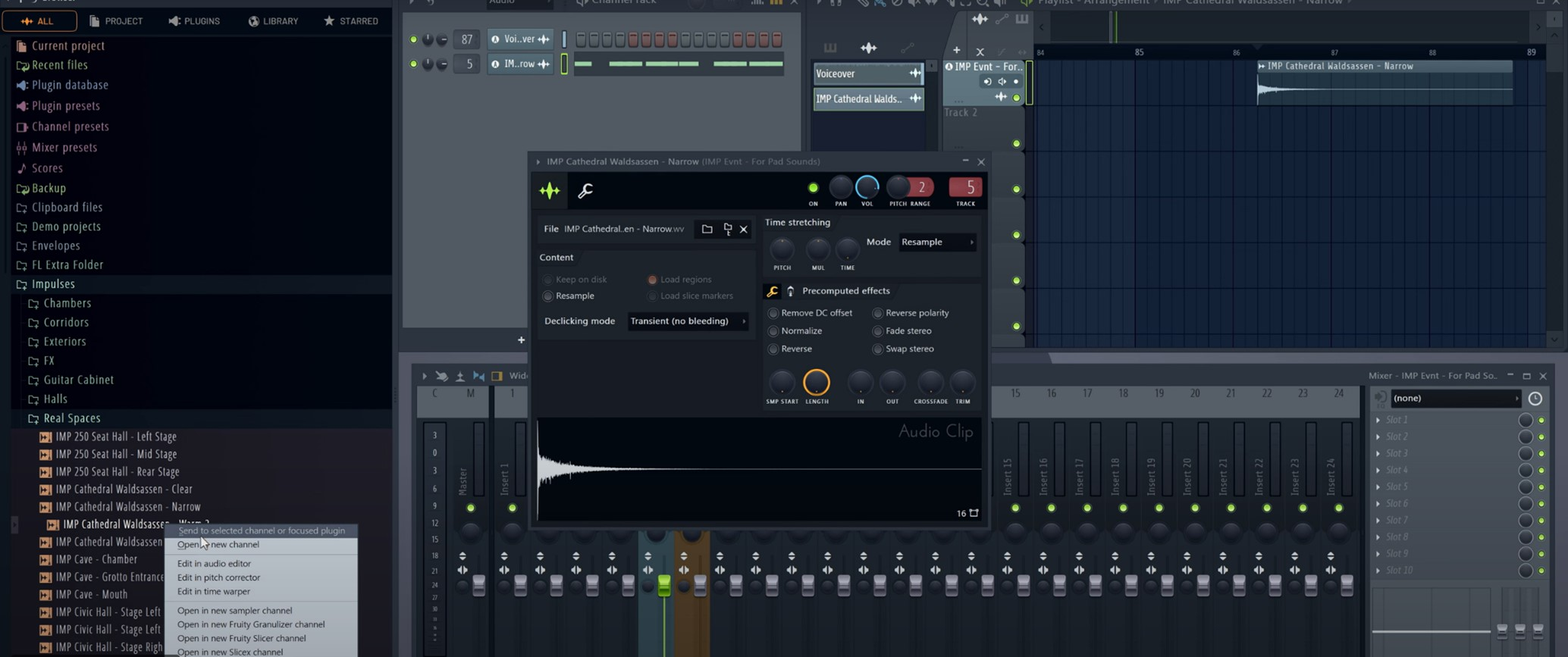
Pros:
It has one of the friendliest user interfaces.
Lifetime free updates.
Loop composition tools.
Batch processing.
Friendly user interface.
Free unlimited trial to learn to use FL Studio.
Cons:
The interface is very different from other DAWs and audio editors, which makes it a love or hate for some users.
Avid Pro Tools - Best Industry Standard Audio Editor for Professionals

Pro Tools is considered among the top in the industry for recording, mixing, and mastering audio for music production, films, sound design, and broadcasting. Its industry-standard tools and features, plus the steep learning curve, make it a complex audio editor for most beginners but not impossible to learn.
Avid offers Pro Tools Intro, a free and limited version of Pro Tools. If you're ready to make the jump but don't want to commit to a subscription yet, you can begin to learn this powerful DAW with Pro Tools Intro.
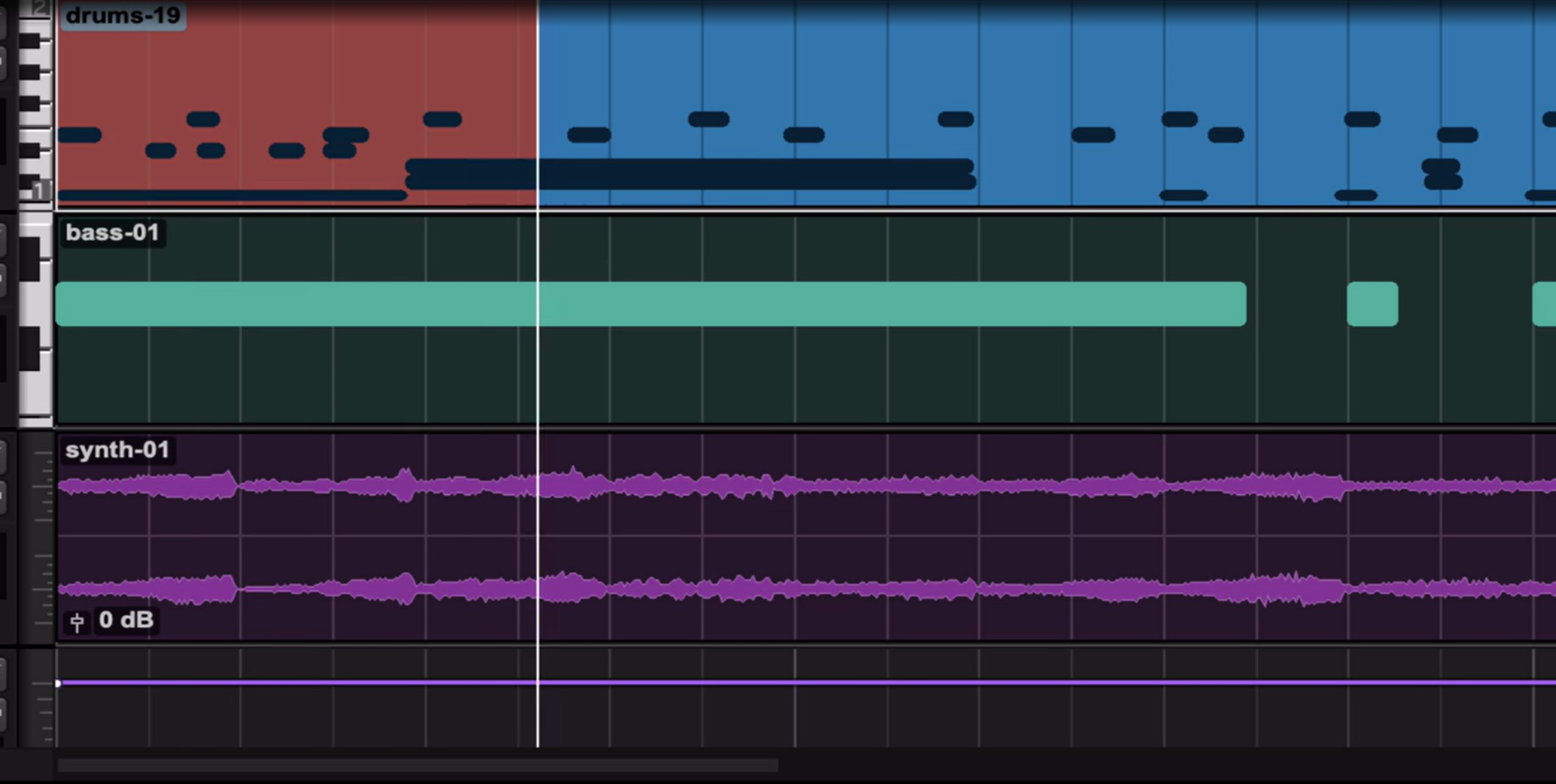
Key Features:
High-quality audio recording.
Multi-track editing.
Powerful and professional editing tools.
Advanced automation.
MIDI editor, sequencer, and effects.
External plug-in support.
Surround sound mixing.
Score editor.
Video files editor
Audio effects, virtual instruments, and sound libraries.

Avid’s Pro Tools is available by subscription only. Four tiers, including the free version, are available to suit everyone's needs.
Pro Tools Intro Free. Get started for free with eight audio tracks and 8 MIDI tracks, 39 instruments and audio effects, and 2GB of loops, sound effects, and samples.
Pro Tools Artists is $9.99 monthly. The first paid tier offers 32 audio and 64 MIDI tracks, over 100 instruments and effects, and Inner Circle and Sonic Drops plug-ins and samples.
Pro Tools Studio $34.99 monthly. It increases audio tracks to 512 audio and adds 1 video track, over 120 virtual instruments and effects, and immersive mixing support.
Pro Tools Ultimate is $99 monthly. The higher tiers for professional studios offer 2,048 audio tracks plus 64 video tracks, full audio post workflows, and immersive mixing support.
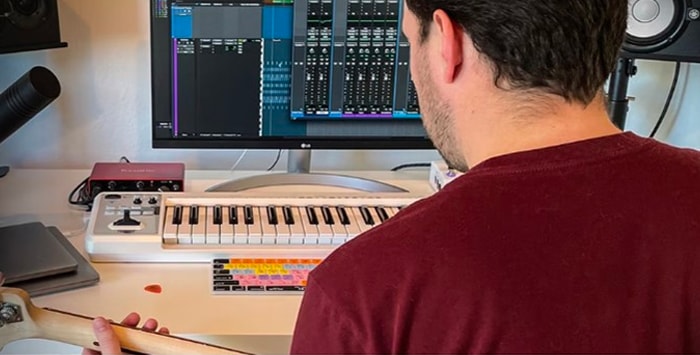
Pros:
Industry-standard tools.
Clean editing workflow.
Pro Tools Intro is free.
Advanced audio editing, mixing, and mastering.
Cons:
Steep learning curve.
Subscription only.
PreSonus Studio One – Best Workflow
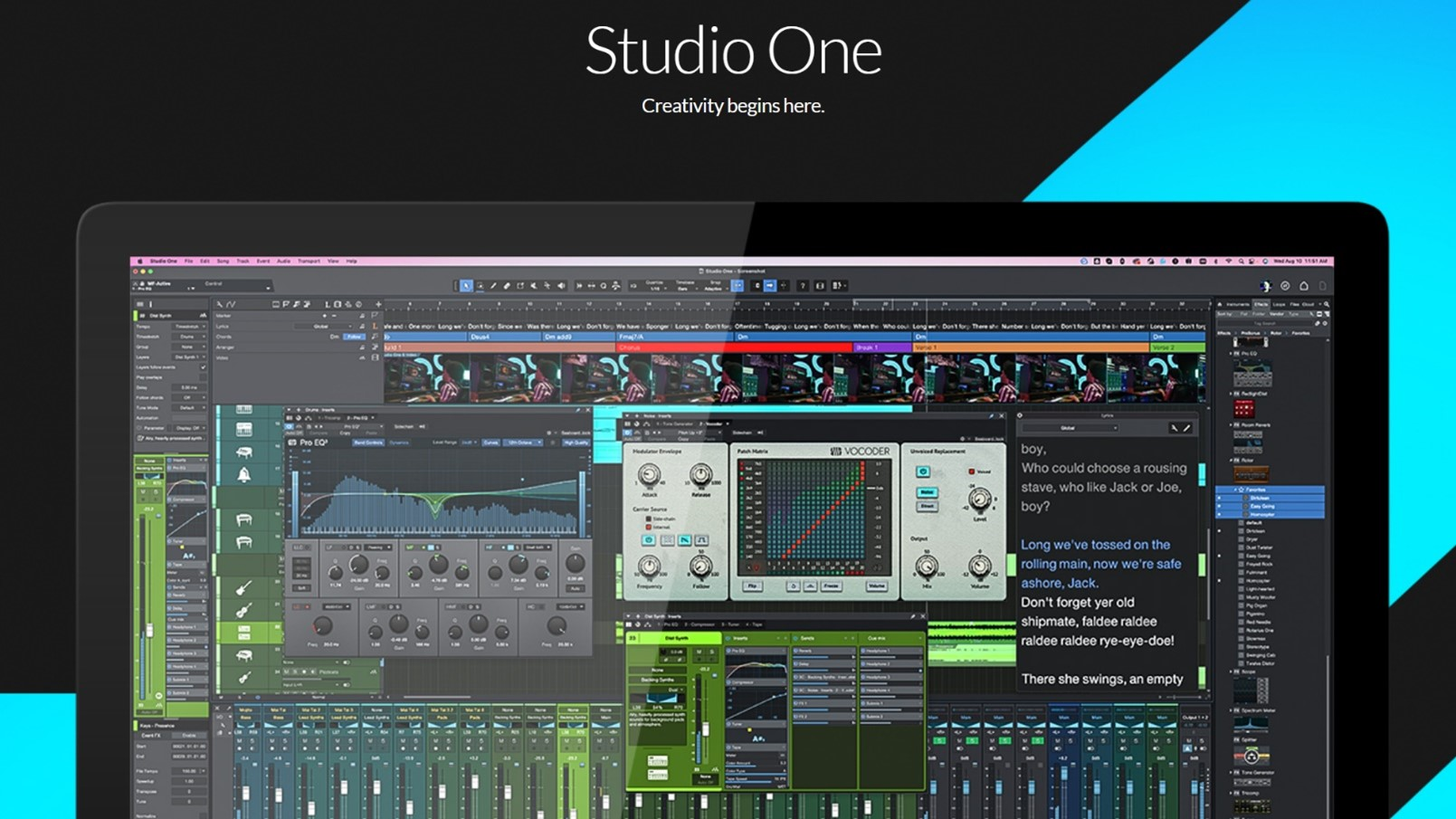
PreSonus Studio One is an audio editor with a very friendly user interface and drag-and-drop workflow. It’s a favorite among artists and audio engineers and perfect for beginners who want to start producing music.
Its fast and flexible workflows allow for different approaches when recording, mixing, and editing audio. Use the classic Arranger Track, the Scratch Pad feature to experiment and test ideas without adding it to your current arrangement, or begin with the beat using the pattern-based sequencer.
Studio One offers a quick-start option called Smart Templates, which chooses the best workflow for each type of project.
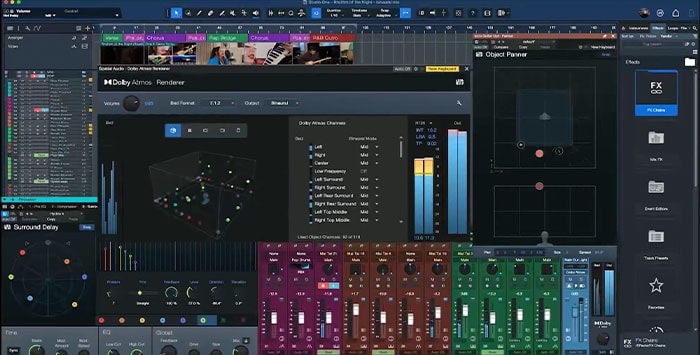
Key Features:
Intuitive drag-and-drop workflow.
Chord Track and Harmonic Editing.
Pattern-based sequencing.
Track presets.
Scratch Pads.
Video file editing.
World-class virtual instruments and sounds.
Melodyne integration.
Vast collection of audio effects.
Integrated mastering suite.
Surround sound, Dolby Atmos support, and Apple Spatial Audio monitoring.
Lyrics integration.
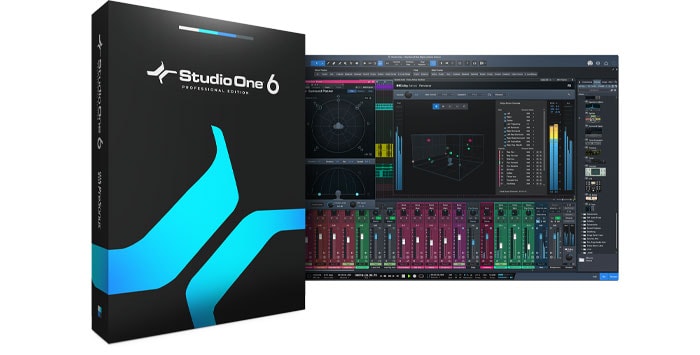
Studio One is available in three models:
Studio One Pro license $399.
Studio One+ $19.99 monthly. The subscription includes Studio One Pro plus additional tools and content.
Studio One+ Hybrid $179.99 yearly is a hybrid model that offers a perpetual license of Studio One Pro plus 12 months of the additional tools and features from Studio One+.
A 30-day free trial is available to download and try the PreSonus audio editor.
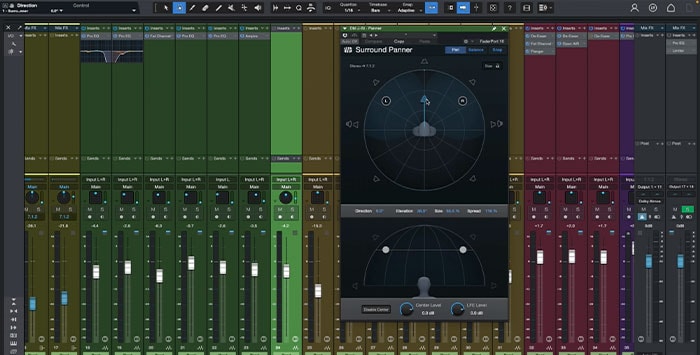
Pros:
Drag-and-drop workflow.
Beginner-friendly.
High-quality effects, instruments, and sounds.
Mastering suite.
Content browser to search for your sounds and loops.
VST support.
Cons:
It still has a steep learning curve.
Fewer built-in plug-ins than other DAWs.
REAPER - Best Budget Audio Editing Software
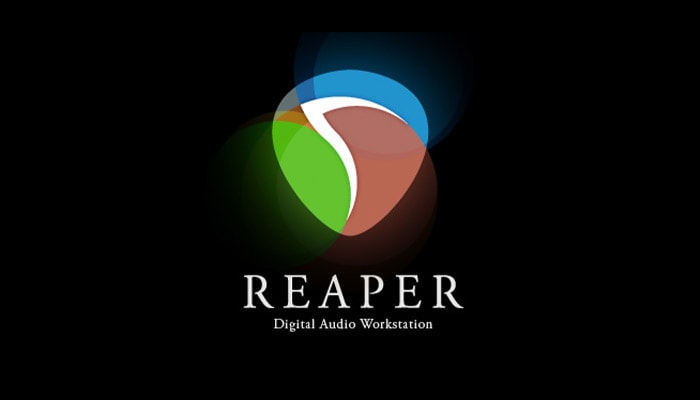
REAPER is an audio editing software that has become more popular for audio post-production. It allows multi-track audio and MIDI recording, editing, mixing, and mastering tools.
REAPER can handle various projects, including music production, mixing and mastering, sound design for films, video games, podcasting, broadcasting, and live recording.
Its minimalist user interface makes it a speedy tool that can be fully customized and extended to fit your workflow.
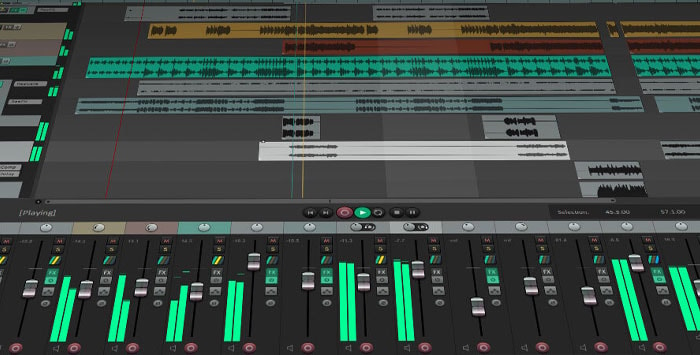
Key Features:
Fast and lightweight.
Multi-tracking.
It can run from a portable device or network drive.
MIDI support.
Third-party plug-in effects and virtual instruments support.
Built-in audio effects.
Scripting.
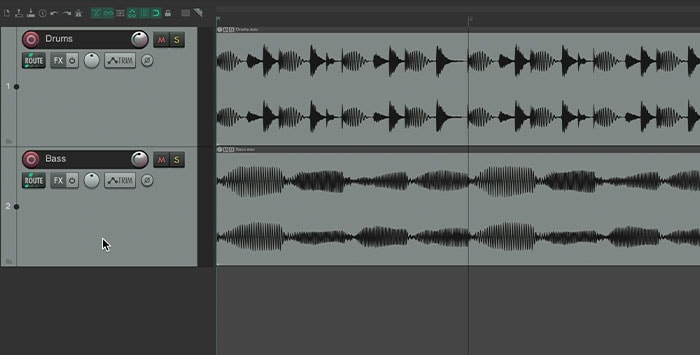
Reaper offers a single-payment license for $60, including unlimited free updates for the REAPER version you purchase. The REAPER license is DRM-free, which means you can install it on all your computers.
Pros:
Very affordable for the full version.
Single-payment DRM-free license.
Custom skins and layouts.
Light footprint.
Regular updates.
Cons:
Steep learning curve.
It does not include any virtual instruments.
Acoustica - Best Paid Alternative for Adobe Audition
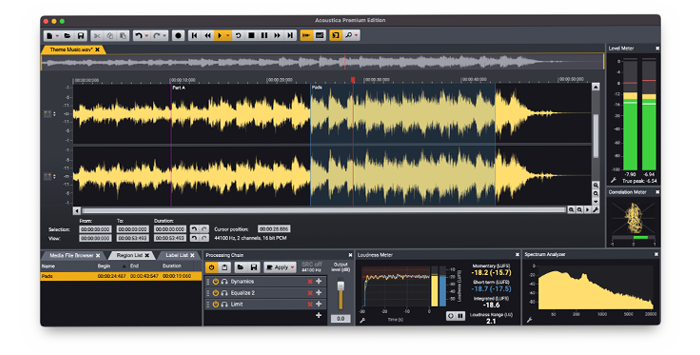
Acoustica, developed by Acon Digital, is a digital audio editor for audio post-production, podcasts, content creation, audio restoration, and mastering with an intuitive, flexible interface and smooth workflow.
Acoustica workflow is fast, features high-quality processing tools for audio projects and restoration similar to Adobe Audition, and supports third-party plug-ins to expand your library.
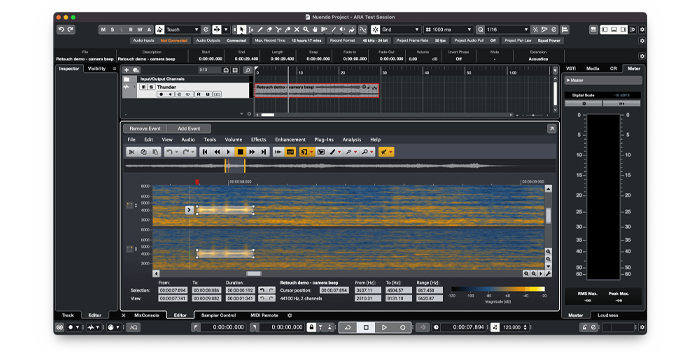
Key Features:
Multi-track editing.
Audio editing and processing tools.
Audio restoration effects and tools.
Analysis tools include a spectrum analyzer, level meters, and spectrogram.
External plug-ins support.
Compatible with multiple audio formats.
Batch processing.
Spectral editing (Premium version).
ARA2 and Host Integration (Premium version).
Surround sound editing (Premium version).
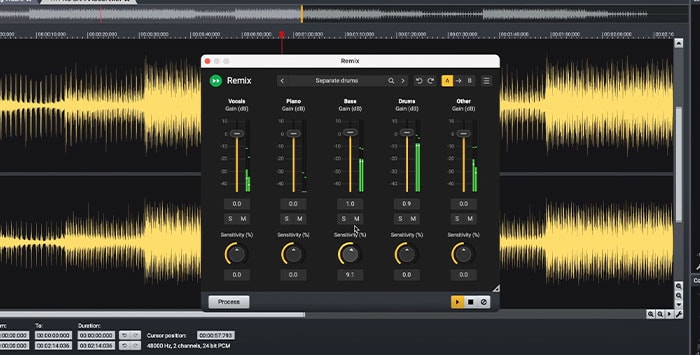
Acoustica is available in several versions:
Acoustica Standard Edition $59.90. The basic tools for audio editing.
Acoustica Premium Edition $199.90. It includes spectral editing and support for immersive audio up to 7.1.2, plus more effects.
Acoustica Post Production Suite is $299.90 and features the Premium Edition plus DeVerberate and DeFilter plug-ins.
You can download a 30-day trial of Acoustica.
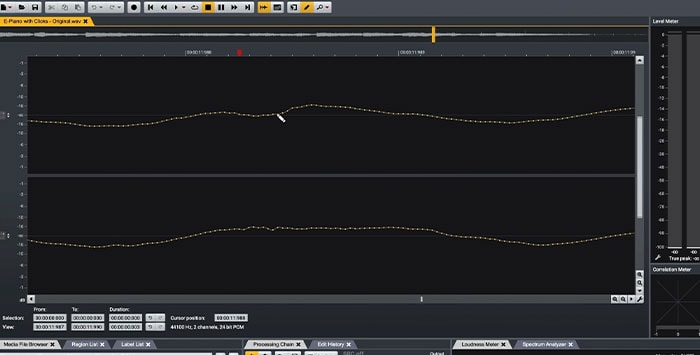
Pros:
Easy to use and beginner-friendly user interface.
Comprehensive editing tools.
Built-in effects.
Affordable price.
Single payment license.
Cons:
It is not competitive with other audio editing software.
Limited MIDI support.
AudioMass - Best Browser-Based Audio Editor
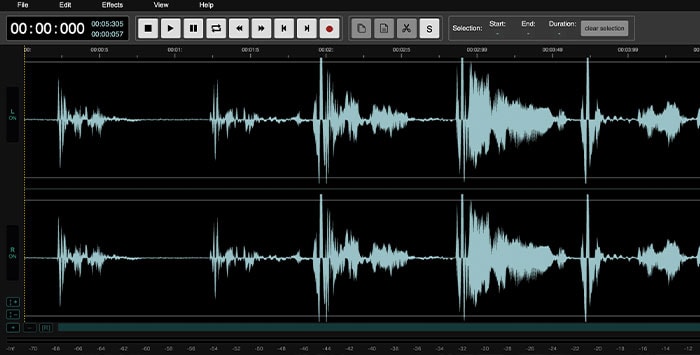
Sometimes, you want a snappy and easy-to-use tool for basic editing. AudioMass offers that in a browser environment that any computer can run, especially for users with low-end computers.
AudioMass is an open-source, free, web-based audio and waveform editing tool. It runs on your web browser with no system requirements other than a browser and internet connection.
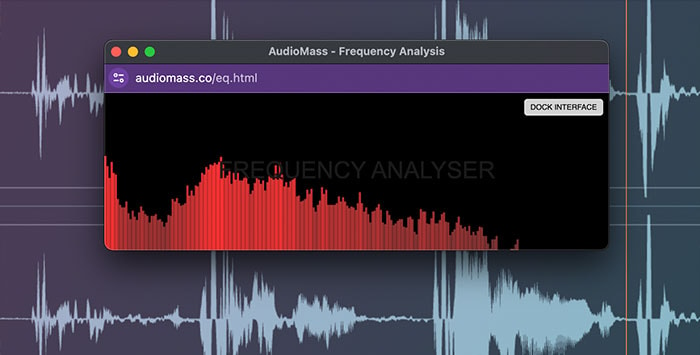
Key Features:
Online browser-based audio recording and editing.
Audio effects include compression, parametric EQ, Reverb, Delay, and Distortion.
Waveform and frequency visualization.
Inverting and reversing audio.
Pitch shift.
Fade in/out.
MP3 export.
Dockable UI.
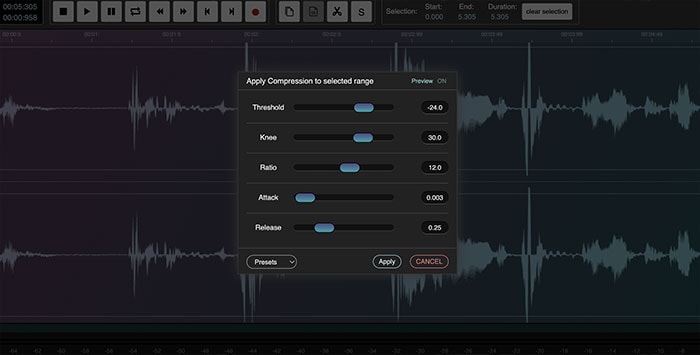
Pros:
Free.
Browser-based.
Easy to use.
Works on low-end computers.
Cons:
Limited to basic audio editing features.
No multi-track editing.
Less advanced features.
It can’t be used offline.
Audio Editing Software Buyer’s Guide
So many questions haunt us when trying to find the best audio editing software for Windows. What should it offer? Is it better to use a free audio editor or a paid one? Subscription or license?
If you ask ten music producers and podcasters, you'll receive over ten answers with lists of the "best audio editing software." To help you understand what makes the best audio editor, I created this buyer’s guide with relevant points you should consider.
Audio Editing Software VS Digital Audio Workstation
A common question is the difference between audio editing software and digital audio workstations. You often hear people talk about them as if they were the same, but though some features overlap, they have key differences.
I will simplify the answer by saying that an audio editor is for audio manipulation and processing, such as cleaning, restoration, and optimal audio levels for your files. Audio editors usually allow you to edit one or two tracks at a time. However, many audio editors now have multi-track features.
A DAW allows multi-track recording, monitoring, editing, and mixing and offers other tools for creating output audio files.
In summary, every DAW is an audio editor or has audio editing features, but not all audio editors are digital audio workstations.
Set Your Goals and Identify Your Needs
Ask yourself what you want to do. If you check our list, you'll notice that the audio editors and DAWs have similar main features, but some offer better workflows for podcasting, others for music production, sound design, etc. Identify why you need an audio editor to start setting goals you want to achieve with it.
Skill Level
Another thing to consider is your skill level. If you're a beginner, starting with something like Audacity, Acoustica, or AudioMass will be easier—something with a user-friendly interface and tons of online tutorials.
If you are at an intermediate level and know basic editing, you could explore options like REAPER, FL Studio, or Studio One.
Advanced and professional users benefit most from DAWs like Pro Tools or Ableton Live.
Platform Compatibility
Ensure the audio editing software you want is available for your Windows, macOS, or Linux computer. Some audio editors, like Apple GarageBand or Logic Pro, are only available for Mac and Apple devices.
Regarding your CPU and hardware requirements, if you want to run Pro Tools, ensure you have a powerful CPU that can handle it. But if you have a low-end GPU or CPU, then running something lighter like Audacity or AudioMass will suit you better.
Key Features:
Certain key features may be important to you based on your needs and goals. Here's a brief but handy reference list of the key features you want in audio editing software for audio post-production.
Look for cut, copy/paste, and trimming features for basic editing.
Multi-track editing if you're producing music, podcasts with multiple speakers, interviews, and sound design.
Ensure it features basic audio effects like reverb, delay, and compression. If you're doing more advanced audio editing, look for VST support.
Virtual instruments if you’re producing music and MIDI support for them.
There is support for multiple audio files formats, or at least the most common ones, such as MP3, WAV, AIFF, FLAC, etc.
Automation features for volume, panning, and effects.
Consider bundled software, sound libraries, instruments, and sound effects.
The complexity of the user interface.
Purchase options.
Free trials.
Budget
Many choices are made based on our budget, and audio editing software is the same. Once you have reduced your options following this buyer's guide, you’ll have to choose which route you want to take.
If you're on a low budget, try some free options like Audacity, Pro Tools Intro, and AudioMass, an affordable tool like REAPER, or pay one month for something like Adobe Audition if your audio post-production work is not recurrent.
It's better to invest in good audio editing software for professional work, but you don't need to spend hundreds if you don't need to. Assess whether you need a license or if a lower-cost subscription will give you the right tools.
Trial Versions
Make the most of trial versions. Almost every DAW and audio editor has one, and some allow you to export your edits with some limitations. Free trials also let you see if the product is worth the investment for the full edition.
Updates
Updates are common in every software, allowing you to enjoy the best version of the audio editing software. Verify how often the software you choose updates or if it includes free updates.
Some products, like FL Studio, provide major updates for free for a lifetime, while others, like Ableton Live, only offer updates for the purchased version. Subscription-based software is more likely to include these updates than one-time-purchase licenses.
Tutorials and Learning Resources
Learning on our own can be hard for some people, and most audio editing software has a learning curve. If you don't understand what something does, need help applying an effect, use effects chains, or export your audio tracks, having resources to help you will make your audio editing process easier.
Almost every DAW and audio editor comes with a manual, but sometimes, having someone else explain it to you via text, audio, or video can help you better. This is especially true for tricky processes that make you wonder if it's you or some bug in the software.
You will find video tutorials on YouTube, but you can also check our blog for tutorials on basic audio recording, editing, and restoration using different audio editing software.
Final Words
You may be thinking by now that no one audio editing software option is better than the others. It all depends on your needs, skill level, and budget, among other things. Evaluate what you need to do and choose the audio software based on it.
The best audio editing software is the one that helps you get the job done with better quality in the right amount of time. It's the one you can master over time, and it will unlock your creativity on your audio post-production journey.
Good luck!











